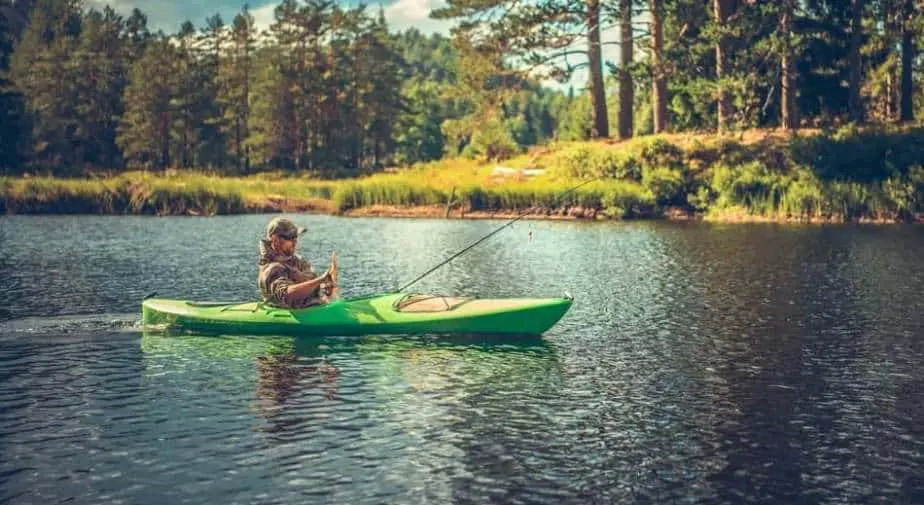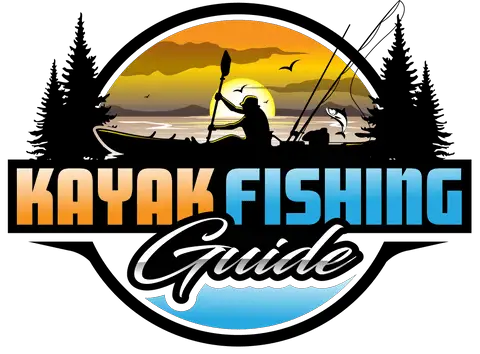
The first time I ever attempted fishing from a kayak was from a sit-in rental kayak on the North Fork of the White River deep in the Ozarks of southern Missouri. We were on a weekend float trip with friends, and I brought a fishing rod along and learned quite a bit from that trip!
Can you fish from a regular kayak? Yes, you can fish from a regular kayak. Regular kayaks are a great way to find out if you are going to enjoy the sport. Once you decide you enjoy it, you may want to invest in a specialized fishing kayak and equipment which enhance your fishing experience.
There are quite a few differences between a regular kayak and a kayak designed for fishing. How you handle these differences can make or break your day on the water. Learning to be comfortable, maneuverable, and safe is key to your fishing day.
Are you deciding which kayak would be best? Check out: Sit-On-Top Vs Sit-In Kayak For Fishing: Which Is Best?
What I learned Fishing in a Regular Kayak
Fishing from a regular sit-in kayak for the first time was quite the experience for myself! A small group of friends and I had decided a weekend float trip on the White River would be a blast. Knowing there were a ton of fish in that stretch of water, I brought along a fishing rod.
In the clear waters of the river, it was reasonably easy to spot fish resting and finning next to submerged rocks and fallen trees. Turning my body and casting toward these fish as I floated down the river, I managed to land several bass and trout. After a day on the water in a rental kayak, I learned a few things to make it easier.
One of the critical things I learned was to be comfortable in the kayak. Once you are uncomfortable, your enjoyment begins to dwindle. Some of the important things I learned about that day was:
- Legs jammed up in the kayak
- Raw spots rubbed on your body
- Lower back soreness
- Minimal space to sit in
- Items (sunblock, sunglasses, water bottle, etc.) rolling around loosely
- Stability of some kayaks
- The ability to stop when needed
Being Comfortable in Your Kayak
The first thing I noticed was my legs jammed up in the kayak. A lot of the inexpensive kayaks most people use are rather small compared to specialized fishing kayaks. If you’re shorter in stature, this may not be an issue for you. But if you are a little taller than the average guy in height, you may also experience this issue.
With smaller inexpensive sit-in kayaks, the hard rim of the seating area will rub against your skin, causing raw spots. If you are always wet or kayaking in swim shorts with your back exposed, skin abrasions will occur and ruin your day.
Smaller kayaks really do not allow for you to move around and stretch adequately, so lower back soreness will quickly ensue. Nothing will take your mind off of fishing or enjoying the day faster than being sore.
Again these kayaks are not built for all-day comfort or for fishing 4-6 hours. You are going to find the seating space is minimal at best for the most part. There will barely be enough room for you to move around. If you are paddling in a straight line or only out having fun, these kayaks are excellent. Though once you begin fishing, the seating area seems to close in on you.
Helpful Seating Tip: Bring along an extra lightweight jacket, you may need to wear it if it rains or cools down during the day. Roll it up and place it behind the small of your back for a bit of comfort.
When you are on the water, you bring along a variety of items. Generally speaking, essential items like sunglasses, sunblock, water bottles, snacks, etc. can be kept to a minimum. Most of these can be kept in your pockets. Water bottles and maybe a small soft-sided cooler may be stuffed into the nose of the kayak.
Once you add fishing gear to your essential items list, the room in a regular kayak rapidly loses its comfort – unless you are in one of those roomy touring kayaks! Even small tackle storage boxes seem like heavy suitcases once you have everything in your kayak.
Being Maneuverable in Your Kayak
Hanging on to your fishing rod while attempting to paddle from spot to spot is cumbersome. Then after you arrive at your fishing spot, you have a paddle to contend with! You can lay it across your body, but even there, it is often in the way.
An anchor of some type is also advisable. When there is even a little wind blowing, your kayak can be driven into the bank or out into the lake. If you are kayak fishing on a stream or river, the currents will keep you moving downstream. The ability to drop an anchor and stop to fish is helpful. Otherwise, you have to paddle to the bank, get out, pull the kayak up, and then begin casting.
Helpful Wind Tip: If you find it to be windy or breezy, locate a section of shoreline you would like to fish that has the wind blowing parallel to it. Paddle upwind and let the wind drift you down the shoreline.
Being Safe in Your Kayak
Most of the inexpensive type of kayaks you find at Wal-Mart, or outdoor stores, are built where you sit low in the water. Your center of gravity is low and more stable. So you are less prone to have the kayak flip over or fall into the water.
These kayaks are very lightweight, and once you attempt to stand up, your center of gravity is higher than the kayak, and they become extremely unstable. Your risk of a flip or falling over is significantly increased.
Small plastic kayaks rarely have an attachment point for high-visibility flags on the kayak. Flags are an excellent thing to display while on a larger body of water, or where you are more likely to encounter other boaters. If you do not have a flag, wear brightly colored clothing ar at least a fluorescent orange cap.
Check out this super “close call” of a kayak without a flag and a high-speed powerboat! You can view it in the article Do I Need a Flag on my Kayak? on this site.
Great for First Time Kayak Fishing
Regular kayaks and the inexpensive models you can pick up from a discount store are great ways to initially begin seeing if kayak fishing is for you. Very often, you will have a friend or neighbor who has one just sitting around in the backyard, the storage shed or hanging in the garage you can borrow.
Even though they are not specifically designed for fishing, these types of regular kayaks are terrific entry-level kayaks. They are:
- Lightweight
- East to carry
- Simple to load on a car or truck
- Easily tied down
- Inexpensive compared to other kayaks
My first fishing adventure was in a rented cheap plastic kayak with a group of friends on a crowded popular river. And although it was many years ago, those memories of reeling in fish from a small, simple, and quite kayak remained with me.
Now years later, I own a serious kayak designed for fishing and have outfitted it with rod and paddle holders, electronics, fishing crates, among other items. The fish do not know what you are fishing from or sitting in. Just getting out is the important thing.
So enjoy your kayak and make some modifications to it as you see fit and learn what you need and like. As time goes on, you may want to upgrade to something designed more toward fishing than merely floating around.
Related Questions
Difference between a regular kayak and fishing kayak? Regular kayaks are more recreational in use and may have a built-in rod holder in case you go fishing; costs are $100+. Fishing kayaks are longer, wider, and very stable platforms you can stand up in. Often costing $1,000 to $5,000 and higher.
Why are fishing kayaks so expensive? Today’s fishing kayaks are using high tech materials not available several years ago, which increases the costs. Plus, any years of research and development go into designing a kayak that is lighter, more maneuverable, and often uses pedal systems or electric motors to power them.
You may be interested in these articles as well!
- Is Kayak Fishing Safe For Non-Swimmers? 7 Best Tips!
- Do Fishing Kayaks Flip Over Easily? The 3 Common Causes!
- Can You Fish in an Inflatable Kayak? Tips & Advice!
- Can You Kayak on Any Body of Water Legally? The Truth
- Nighttime Kayaking: Light Requirements Explained
Be safe and have fun out there!
